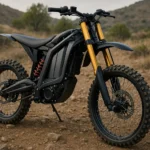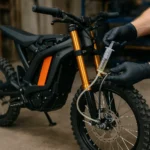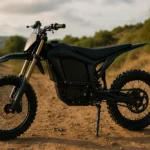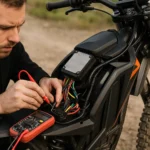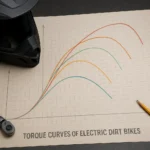Every rider—whether it’s a teenager hitting trails for the first time or a parent buying their kid’s first e-dirt bike—always asks the same thing: how far can it really go on a single charge? That’s why an electric dirt bike real-world range test matters. Instead of relying on glossy marketing or controlled lab numbers, this is about real tracks, real batteries, and honest results 🚵.
When we talk about battery life and performance, the electric dirt bike real-world range test gives us insights into how terrain, speed, and even weather conditions truly affect distance. These practical tests highlight the gap between advertised range and what happens when you ride through mud, climb steep trails, or push your bike at higher speeds.
👉 Before diving deeper, check out our complete guide on the fastest electric dirt bikes to see how speed influences endurance and why it connects directly with range performance.
Finally, an electric dirt bike real-world range test gives riders confidence. It’s not about numbers on paper—it’s about preventing battery anxiety, planning safe trips, and making the most of your electric dirt bike ⚡.
Key Takeaways
- Real-world range is often 20–30% lower than manufacturer claims.
- Terrain, rider weight, and riding style have the biggest impact.
- Weather conditions can drastically shift battery output.
- Knowing true range means fewer surprises and more fun on the trail.
⚡ Heads-up: This guide breaks down proven results, practical factors, and real community insights. Use the quick links below to jump straight to the part you care about most 👇
Why Real-World Range Tests Matter
Most manufacturers publish range numbers based on perfect lab conditions, but riders rarely experience that in the real world. A smooth indoor track and a lightweight test rider might deliver impressive mileage, but trails, hills, and unpredictable weather change everything 🌧️.
That’s why an electric dirt bike real-world range test is so valuable. It shows what happens when you actually push an e-dirt bike through sand, mud, or steep inclines. These situations drain the battery faster, revealing the true performance riders can rely on.
Parents buying for their kids and seasoned riders alike benefit from this information. Instead of guessing, they get realistic expectations of battery life, which means fewer surprises and better planning before hitting the trail. With real results, you can focus on enjoying the ride instead of worrying about when the motor will cut out.
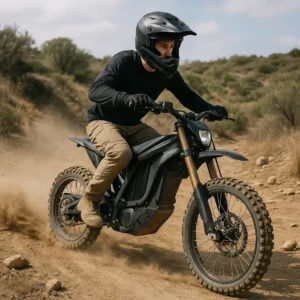
Top 5 Factors That Impact Range
When it comes to battery performance, there are multiple elements that decide how far your e-dirt bike can actually travel. A single ride can feel completely different depending on the conditions, even with the same bike and battery setup ⚡.
One of the biggest influences is rider weight. A lighter rider puts less demand on the motor, while a heavier rider forces the battery to work harder, reducing distance. Terrain is another key factor. Riding across flat dirt or smooth gravel usually gives better results than climbing rocky hills or powering through deep sand.
Speed plays a massive role as well. Aggressive throttle use drains energy faster than steady cruising. Weather conditions also matter: cold temperatures can cut range significantly, while extreme heat can strain long-term battery health. Finally, tire choice and pressure directly affect rolling resistance. Knobby tires provide grip but can eat up energy, while a properly inflated hybrid tire might extend range.
Understanding these variables makes an electric dirt bike real-world range test more accurate and useful, since it reflects the way riders truly experience their machines on different trails.
Case Study: 3 Real-World Range Tests Compared
To understand how claimed numbers stack up against reality, it helps to look at actual results from riders in the field. Manufacturers often highlight their maximum advertised range, but side-by-side comparisons tell a different story 🚴.
In these tests, bikes were ridden by average-weight riders across mixed terrain. The findings showed that some models perform close to expectations on flat dirt tracks, while others fall short once hills, mud, or uneven ground come into play. The table below highlights the gap between specifications and what riders actually experienced.
| Electric Dirt Bike | Advertised Range | Real-World Range | Test Conditions |
|---|---|---|---|
| Sur Ron Light Bee X | 60 miles | 38 miles | Mixed terrain, 170 lbs rider |
| Segway X260 | 74 miles | 42 miles | Hard pack trail, 150 lbs rider |
| Razor MX650 | 17 miles | 11 miles | Flat dirt track, 120 lbs rider |
These comparisons show the importance of relying on an electric dirt bike real-world range test rather than glossy spec sheets. Actual rides reveal how terrain, rider weight, and conditions truly affect endurance, giving a much clearer picture of performance.
How to Do Your Own Range Test
One of the best ways to understand your bike’s true performance is to run your own ride experiment. Doing a personal test doesn’t require expensive tools—just attention to detail and consistency 📋.
Start by choosing a familiar route. This makes it easier to compare results over time. Make sure to track mileage using either your bike’s odometer or a GPS app on your phone. Record details like terrain type, temperature, and your average riding speed. These small notes help explain why battery life changes from ride to ride.
An electric dirt bike real-world range test at home also gives riders confidence. By repeating the same route under different conditions, you’ll learn exactly how your bike reacts to mud, hills, and cold weather. That knowledge makes it easier to plan trips without worrying about running out of juice halfway through the ride ⚡.
For more insights, check out this detailed breakdown of real-world battery performance from Electric Cycle Rider, which compares how several popular e-dirt bikes handle distance outside of lab conditions.
Real Riders’ Insights
Numbers and charts are helpful, but nothing beats the feedback from actual riders. Community forums and rider groups often share firsthand experiences that highlight how e-dirt bikes perform in everyday use 🏞️. These insights usually reveal details that don’t show up in spec sheets, like how a bike handles in deep mud or how quickly the battery drains when climbing long hills.
Some riders note that lighter users on smoother terrain often get close to advertised range, while heavier riders or aggressive trail riders see a noticeable drop. Others emphasize how cold mornings can shave miles off a ride, making planning essential for longer trips.
This is where the value of an electric dirt bike real-world range test becomes obvious. Real-world stories validate lab data while also exposing the hidden variables—like throttle control, tire pressure, and even riding gear weight—that impact endurance. These personal accounts help build a realistic picture of what new owners should expect once they hit the trail.
How Parents Can Plan for Range with Kids
When young riders head out, the last thing parents want is a sudden battery cutoff in the middle of a trail. Planning ahead is key to keeping rides safe and fun. Start by teaching kids how to pace themselves—steady throttle control goes a long way in conserving energy ⚡.
Carrying a portable charger or even a backup battery can prevent frustration on longer outings. It’s also smart to map out shorter loops close to home or the truck, so riders don’t push the bike past its limits. Weather should also be considered, since cold mornings or hot afternoons can affect endurance.
Understanding these factors makes an electric dirt bike real-world range test even more practical for families. Parents who want to balance safety with excitement can also explore our guide on the fastest electric dirt bikes to see how speed connects directly to battery drain.
Pro Tips to Extend Your Range
Even the best battery will drain faster if you ride without strategy. Small adjustments in riding habits and bike setup can make a huge difference in how long you stay on the trail 🔋.
One proven method is smooth throttle control. Riders who avoid sudden bursts of acceleration usually get more miles out of a single charge. Maintaining steady speed rather than aggressive stop-and-go riding reduces unnecessary energy loss.
Battery care is just as important. Avoid letting the battery drain completely, and stick to proper charging cycles. Keeping it stored at moderate temperatures also helps preserve long-term capacity.
Finally, don’t overlook the bike’s setup. Proper tire pressure lowers rolling resistance, while a well-lubricated chain keeps the drivetrain efficient. Paying attention to these details ensures that an electric dirt bike real-world range test reflects the very best performance your machine can deliver.
FAQs About Electric Dirt Bike Range
Q: How much lower is real-world range compared to advertised numbers?
A: On average, riders see a drop of 20–30% once factors like terrain and speed are added.
Q: Do kids’ e-dirt bikes last longer or shorter on the trail?
A: Smaller models often have limited batteries, so their range is usually shorter than full-size bikes.
Q: Can weather really cut performance in half?
A: In freezing conditions, yes. Low temperatures reduce battery efficiency dramatically, sometimes by 40–50%.
Q: What tools can I use to measure my rides?
A: GPS tracking apps paired with the bike’s odometer give the clearest picture of distance traveled.
These common questions show why an electric dirt bike real-world range test is essential. It doesn’t just give a number—it provides clarity, helping riders of all ages plan safer, smarter, and more enjoyable rides.
Final Thoughts: Don’t Fear the Range, Learn It
At the end of the day, range shouldn’t be something that holds riders back. Instead, it’s a tool that helps plan adventures, manage expectations, and avoid unpleasant surprises on the trail 🌲.
An electric dirt bike real-world range test is more than just numbers—it’s a way to build confidence. Riders who understand how weather, terrain, and riding style affect battery life can focus on enjoying the ride rather than stressing about when the power will cut out.
By treating each outing as a chance to learn, riders create their own library of insights. Over time, this knowledge makes every trip smoother, safer, and far more fun.
Share Your Ride Experience
Every rider’s journey is different, and your feedback helps others in the community learn what to expect from their bikes 🚵. Whether you’ve tested your endurance on rocky hills or enjoyed a smooth run on dirt tracks, sharing your insights can make a big difference for new riders.
An electric dirt bike real-world range test isn’t just about the numbers—it’s about building trust and confidence across the riding community. Drop a comment with your results, let us know your setup, and compare your experience with other enthusiasts.
And if speed thrills you as much as range, don’t miss our guide on the fastest electric dirt bikes. Your story could inspire others and help them get the most out of their rides.

Tyler Brooks is the storyteller behind most of the content at Electric Dirt Zone. With over 10 years of experience in digital media and a lifelong love for off-road riding, he blends technical insight from the team with engaging, down-to-earth writing. When he’s not turning dusty trail rides into blog posts, you’ll probably find him snapping pics before things get too wild.

